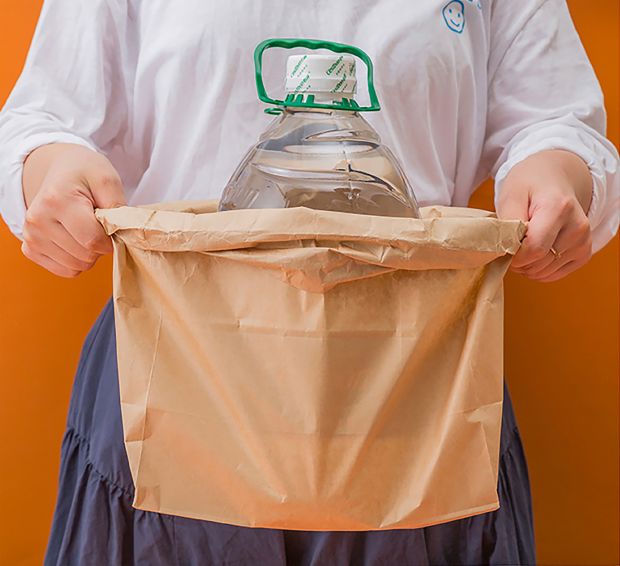What is a compostable packaging?
People often equate the term compostable with biodegradable. Compostable means that the product is capable of disintegrating into natural elements in a compost environment. This also means that it does not leave behind any toxicity in the soil.
Some people also use the word “biodegradable” interchangeably with compostable. However, it is not the same. Technically, everything is biodegradable. Some products, however, will only biodegrade after thousands of years!
The composting process must typically occur in about 90 days.
To get genuine compostable packaging products, it is best to look for the words “compostable”, “BPI certified” or “meets ASTM-D6400 standard” on it.
Some companies print misleading labels as a marketing tactic, using words such as “bio-based”, “biological” or “earth-friendly”, to name a few. Please note that these are not the same.
In short, compostable and biodegradable are different. Especially when it comes to packaging, you should always be careful about which type you are using.
Compostable plastic packaging is capable of undergoing aerobic biological decomposition in a compost system. At the end of it, the material will become visually indistinguishable as it has been broken down naturally into carbon dioxide, water, inorganic compounds and biomass.
Samples of this eco-friendly packaging include items such as take-out containers, cups, plates and service ware.
Types of environment-friendly packaging
A wave of eco-friendly alternatives to replace traditional packaging materials have recently emerged. There seems to be no end to the available options.
Here are a few materials that your business can consider for compostable packaging.
Corn Starch
Corn starch is an ideal material for food packaging. Packages made out of this material have limited or have no negative impact on the environment.
Derived from the maize plant, it has a plastic-like property but is more environmentally friendly.
However, as it is derived from the grains of corn, it may compete with our human food supply and possibly raise the price of dietary staples.
Bamboo
Bamboo is another common product that is used to prepare compostable packaging and kitchen ware. Being commonly available in various parts of the world, it is considered a very cost-efficient source as well.
Mushroom
Yes, you read right – mushrooms!
Agricultural waste is ground and cleaned and then fused together by a matrix of mushroom roots known as mycelium.
These agriculture waste, which is not a food course for anyone, is a raw material that is molded into packaging forms.
It degrades at an incredible rate and can be composted at home to be broken down into organic and non-toxic matter.
Cardboard and Paper
These materials are biodegradable, recyclable and reusable. They are also lightweight and strong.
To ensure the cardboard and paper you use for your packaging are as eco-friendly as possible, try to source post-consumer or post-industrial recycled materials. Alternatively, if it is marked as FSC-certified, it means that it is sourced from sustainably managed forests and could be an even better choice.
Corrugated Bubble Wrap
We are all very familiar with bubble wrap. It’s a favourite in many households, especially in households with children.
Unfortunately, not all bubble wrap is eco-friendly since it is made of plastic. On the other hand, there are a number of alternatives that are developed such as the ones made up of up-cycled corrugated cardboard.
Instead of just disposing or directly recycling cardboard waste, using it as a cushioning material gives it a chance at a second life.
The only downside to that is you don’t get the satisfaction of popping the bubbles. Small cuts are made in the corrugated cardboard so that a concertina-type effect protects against shocks, just like how bubble wrap does.
Are compostable products better?
In theory, “compostable” and “biodegradable” should mean the same thing. It should mean that organisms in the soil can break down a product. However, as we stated above, biodegradable products will biodegrade at an unspecified time in the future.
It is, therefore, better for the environment to use compostable products as it is gentler and can break down into different microorganisms.
It curbs, to an extent, ocean plastic disaster. compostable bags dissolved in marine water within three months. It is, therefore, less harmful to marine organisms.
Is compostable packaging more expensive?
Some eco-friendly packaging is two to ten times more expensive to produce as compared to non-biodegradable materials.
Non-biodegradable materials have their own hidden costs. Take, for example, conventional plastic bags. It may be cheaper on the surface when compared to eco friendly packaging but when you factor in the cost of remediating the toxic chemicals that are released in landfills, compostable packaging is more appealing.
On the other hand, as the demand for eco-friendly disposable containers increases, the price will fall. We can hope that prizes can eventually become comparable to non environment-friendly packaging competitors.
Reasons to switch to compostable packaging
If you need a few more reasons to convince you to make the switch over to compostable packaging, here are some.
Reduce Carbon Footprint
By using biodegradable and eco-friendly packaging, you will be able to reduce the impact on the environment. Made from recyclable or recycled waste materials, it requires fewer resources to produce.
It also will not take years to break down in landfills, thus is gentler on the environment.
Lower Shipping Costs
Compostable packaging is designed with minimalism in mind. It is less bulky and requires less overall material though it still provides adequate protection for any items contained within it.
Packages that weigh less are of course charged less in terms of shipping.
With less bulk to packaging, it is also possible to fit more packages in a pallet in each shipping container as these materials take up less space. This will result in a decrease of shipping costs as fewer pallets or containers are required to ship the same number of products.
Ease of Disposal
With e-commerce becoming increasingly popular, packaging materials make up the majority of rubbish that ends up in landfills.
Using compostable packaging is much easier to dispose of than those that are not. Even if they do end up in landfills, it will break down much faster than their non-compostable, non-biodegradable counterparts.
Improved Brand Image
Nowadays, consumers are a lot more educated and take many factors into consideration before purchasing a product or supporting a company. A large percentage of customers feel better about purchasing products with packaging that is eco-friendly.
Going green is a major trend and consumers are searching for sustainable and environmentally friendly products. By switching to say, food packaging that is compostable, it may give an additional edge to your food business and appeal to more customers.
Conclusion
It is more important than ever to take steps to reduce your impact on the environment. Switching to eco-friendly packaging is a very cost-effective way to lower your carbon footprint. No matter what industry you are in, biodegradable packaging is versatile enough to suit any application. It may take a bit of an upfront investment but by making the switch, it will likely save you a lot of money on supplies and shipping costs in the long run.

Post time: Aug-29-2022







